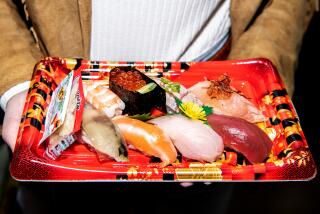Market Watch: The cold beauty of colored kale
- Share via
Colored kale plants with red or purple centers and greenish outer leaves have long been popular as ornamental plants, for home gardens and street landscaping. Although edible, they were really more beautiful than delicious; but several newer varieties that have become available at farmers markets in recent years offer exceptionally sweet flavor and tender texture in addition to striking appearance. They’re at their best in midwinter and add festive color to holiday tables.
One of the local pioneers of colored kale cultivation is Jacob Grant of Roots Organic Farm, who became intrigued four years ago by a catalog description of the Chidori variety and now grows a quarter acre of it in Los Olivos, north of Santa Barbara. The season runs from October to March or April, but the coldest days of winter are Chidori’s time to shine.
“Where I farm in the Santa Ynez Valley, we get subfreezing temperatures almost every night in the wintertime, and that drastically improves the flavor, color and texture,” says Grant. “In response to frost, kale produces sugar, which acts like an antifreeze, and cold also makes the colors darker.”
The color comes from anthocyanin pigments, which are water soluble, and in some reddish vegetables can bleed, giving them a muddy color. But Chidori kale holds its color pretty well; if anything, it darkens a bit, into a richer pink or fuchsia.
The flavor is milder than that of most other kales and the texture more succulent. Grant likes to stir-fry his Chidori kale in olive oil with shallots, carrots and chicken, adding soy sauce, lime juice and coconut milk at the end. It is also good steamed and requires a bit less cooking time than other kales.
Young Chidori kale is tender enough to use in a salad, and the stems are less tough and stringy, so you can trim them rather than remove the whole stem. Grant makes a dressing for it from a 50/50 mix of balsamic vinegar and olive oil, with hummus added for a creamy texture and apple cider for a touch of sweetness. He puts on the dressing about 20 minutes before eating, which tenderizes the leaves, he says.
The name Chidori, which means “a thousand birds” in Japanese, supposedly refers to the contrast between the flat surfaces of the leaves and their frilly edges. Unlike other kales, which traditionally are bound in bunches by their stems, it is mostly the smaller inner leaves of the Chidori variety that are used, so Grant sells it loose.
This arrangement is a bit unorthodox for kale, but “people are cool with it,” he says. “It took me at least two seasons to develop a customer base, and now people look forward to it.”
Grant sells at the Santa Barbara farmers markets on Saturdays and Tuesdays, and at the Malibu and Ojai markets on Sundays. (Over the Christmas and New Year’s holiday weekends, he’ll be at Santa Barbara both Saturdays and at Ojai on New Year’s Day.)
Fairview Gardens of Goleta grows another similar Japanese variety, Nagoya, which it started offering at the Santa Monica Wednesday and Santa Barbara Saturday markets a month ago. They have about a quarter acre in the ground and plan to sell Nagoya for much of the year, with a break in summer, says Shawn McMahon, farm manager. At first customers appeared to be mystified by the idea of buying loose kale, but sales picked up when the stand offered in it bags, he adds. Melisse restaurant in Santa Monica has been serving the ruddy leaves as a garnish with sweetbreads.
Several growers, including Fairview, also offer the Redbor variety, which is like a magenta version of the standard Winterbor curly kale.
“It’s the sweetest kale, and it’s my favorite for raw salad, because it’s more tender than lacinato and black kale,” says Johanna Finley of Santa Ynez, who sells Redbor at the Santa Monica gowntown market on Saturdays and at Hollywood on Sundays. (Hollywood is closed on Christmas; Finley Farms won’t be at Hollywood on the substitute market planned for Christmas Eve but will be there on New Year’s Day.)
More to Read
Eat your way across L.A.
Get our weekly Tasting Notes newsletter for reviews, news and more.
You may occasionally receive promotional content from the Los Angeles Times.










